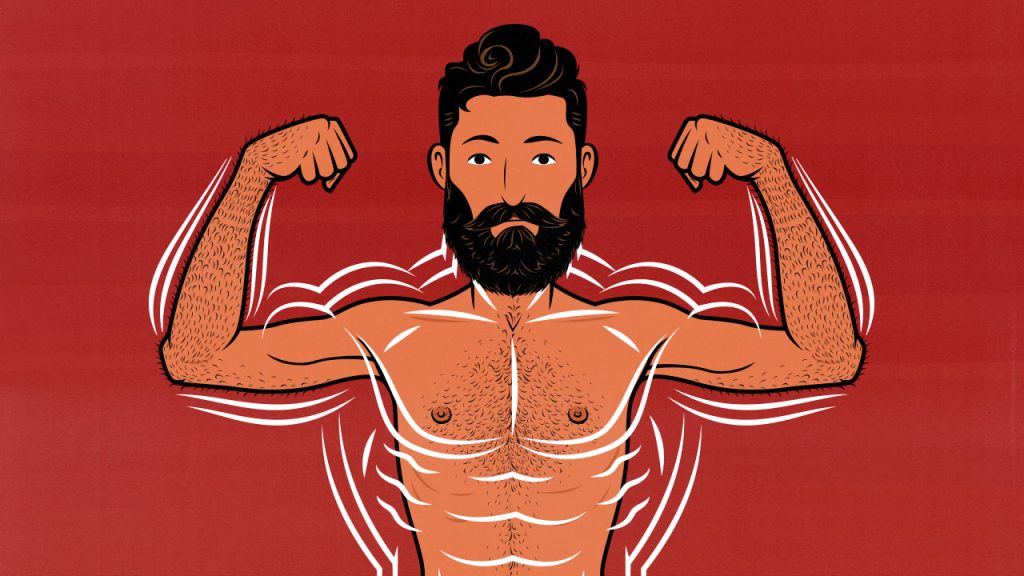
The Best Upper-Body Workout for Building Muscle
An upper-body workout trains most of the muscles in your upper body. When you split your body in two, you could train it half as much but twice as often, making your workouts shorter and easier. Or you could devote more time and energy to the muscles you’re training, giving them a greater stimulus to grow.
These upper-body workouts go best with at least one lower-body per week. There was a primeval species who neglected to do so, and with every generation, their legs withered away. Undeterred, they propelled themselves through the air with their powerful arms and chests. That is how birds came to be. That’s why people who skip leg day are called chickens.
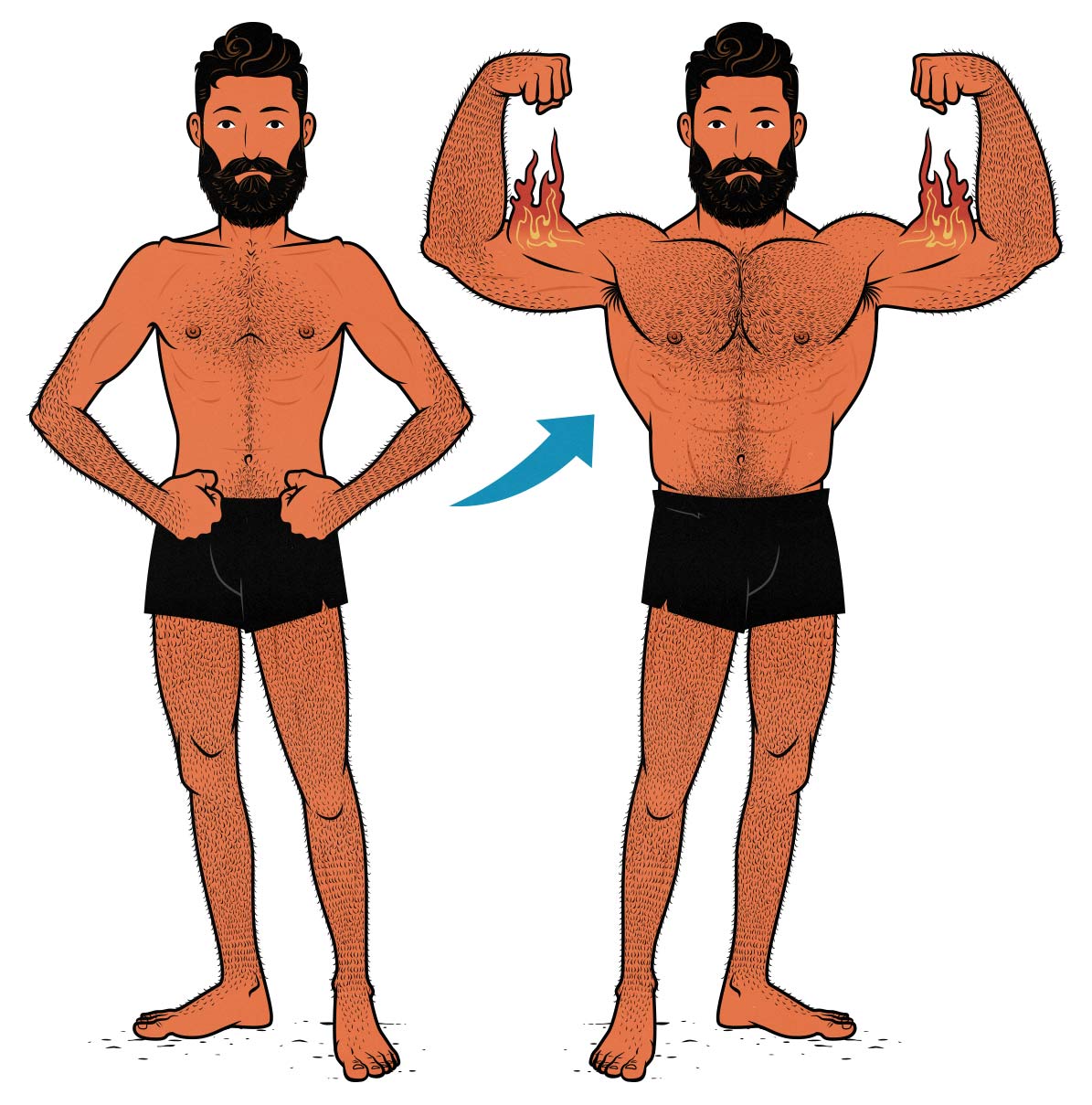
What Are Upper-Body Workouts For?
Upper-body days are usually part of Upper/Lower Workout Splits, where you alternate between training your upper body and your lower body, like so:
- Monday: Lower Body
- Tuesday: Upper Body <=
- Wednesday: Rest or Cardio
- Thursday: Lower Body
- Friday: Upper Body <=
- Saturday: Rest or Cardio
- Sunday: Rest
You don’t have to give your upper and lower body equal emphasis, though. It’s fine to have 3 upper-body workouts and 2 lower-body workouts. You could also create a specialization routine where you train your upper body twice per week and your lower body just once. Or vice versa.
Muscles Worked
Upper-body workouts train your chest, back, arms, and shoulders—with a couple of exceptions. You don’t need to intentionally train your abs, spinal erectors, or upper traps. It’s usually better to focus on those muscles during your lower-body workouts.
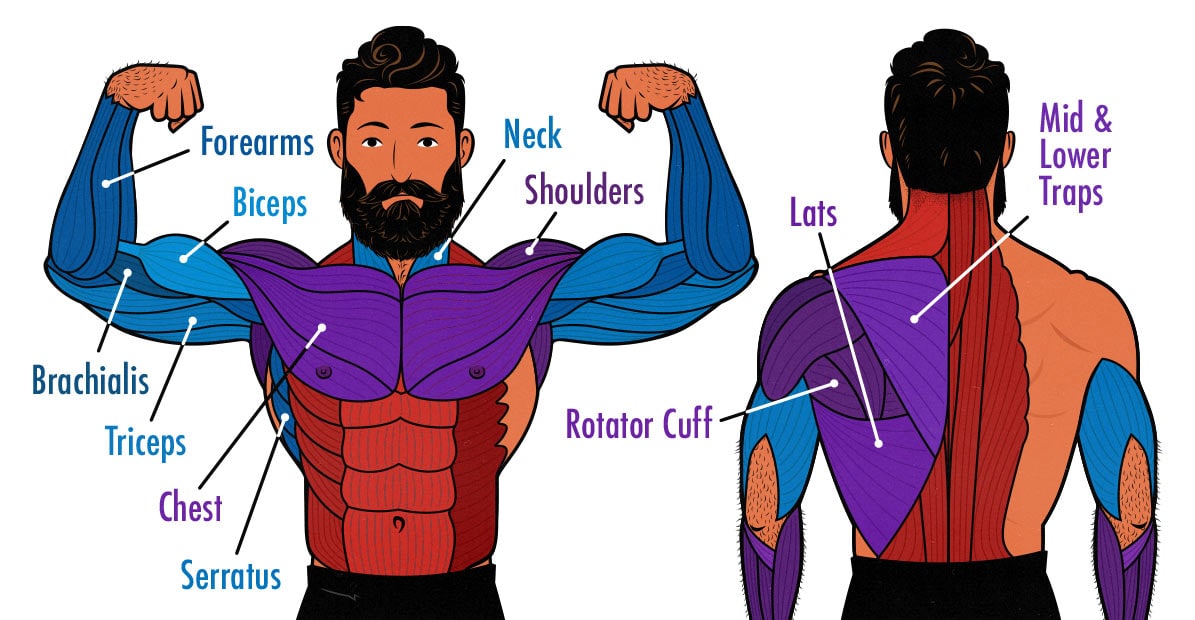
You don’t need to avoid your abs, erectors, and traps. Push-ups and pull-ups challenge your abs. Rows and bench presses challenge your spinal erectors. Overhead presses and lateral raises challenge your upper traps. It’s perfectly fine if they get some extra stimulation. You just don’t need to train them on purpose.
The Best Exercises
Chest Exercises
Your chest has fibres that connect to your abdomen (lower chest), sternum (mid-chest), and collarbones (upper chest). You can work all of those fibres with push-ups, dips, and bench presses. If your upper chest lags, use a narrower grip or add some incline pressing.
- Push-ups are great for your chest, shoulders, and triceps, as well as your abs and serratus anterior. They’re the best chest exercise until you grow too strong for them.
- The barbell bench press is great for your chest, front delts, and triceps. It’s a stable exercise that can be loaded heavy, making it great for intermediate lifters.
- The dumbbell bench press puts more emphasis on your chest and (depending on your proportions) works it through a deeper range of motion. On the other hand, it’s less stable than the barbell bench press and doesn’t work your triceps as hard.
- Dips challenge your chest under an incredibly deep stretch, stimulating a truly fearsome amount of muscle growth in your chest, front delts, triceps, and serratus anterior. They’re amazing for the people who can do them.
- The Chest Press machine is just as good as the bench press for bulking up your chest and front delts. It’s a great option.
- The chest fly is great for isolating your chest. Machine flyes and dumbbell flyes challenge your chest under a deeper stretch. I suspect this makes them better than cable flyes (full explanation).
I recommend including at least one exercise that works your serratus anterior (like push-ups or dips). That will keep your shoulders strong and healthy, and it will bulk up the muscles underneath your armpits.
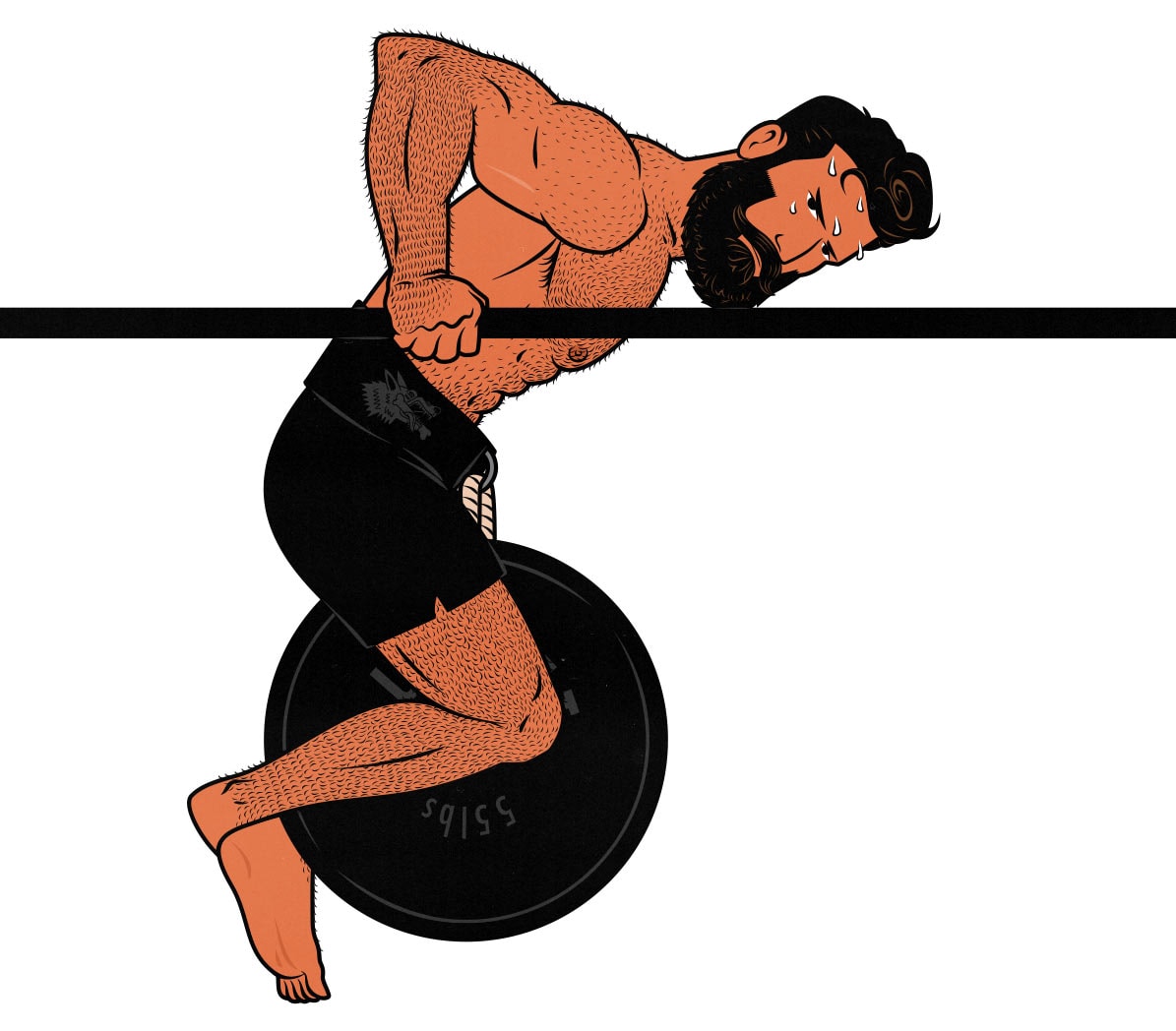
Back Exercises
Your back will grow best if you train it with a few different pulling movements: shoulder extension (chin-ups), adduction (pull-ups), external rotation (face pulls), and retraction (rows).
- Chin-ups and pull-ups work most of the muscles in your back, along with your biceps, forearms, and abs. An underhand or neutral grip is great for your upper lats, and it will allow you to lift heavier. An overhand grip is a little bit better for your lower lats.
- Pulldowns are similar to chin-ups and pull-ups, but they don’t work your abs as hard, and you don’t need to be as strong. You can use an underhand, neutral, or overhand grip.
- One-arm dumbbell rows are simple, easy on your spinal erectors, and great for bulking up your lats and rotator cuff.
- Seated cable rows: Great for working your spinal erectors and lats through a deep range of motion. You can round forward at the bottom, stretching out all your back muscles.
- Chest-supported rows (like the t-bar row) are great for bulking up your upper back and lats without tiring out your spinal erectors.
- Pullovers are great for challenging your lats under a deep stretch.
You’ll notice that the king of back exercises is missing. That’s okay. You can do deadlifts on one of your lower-body days.
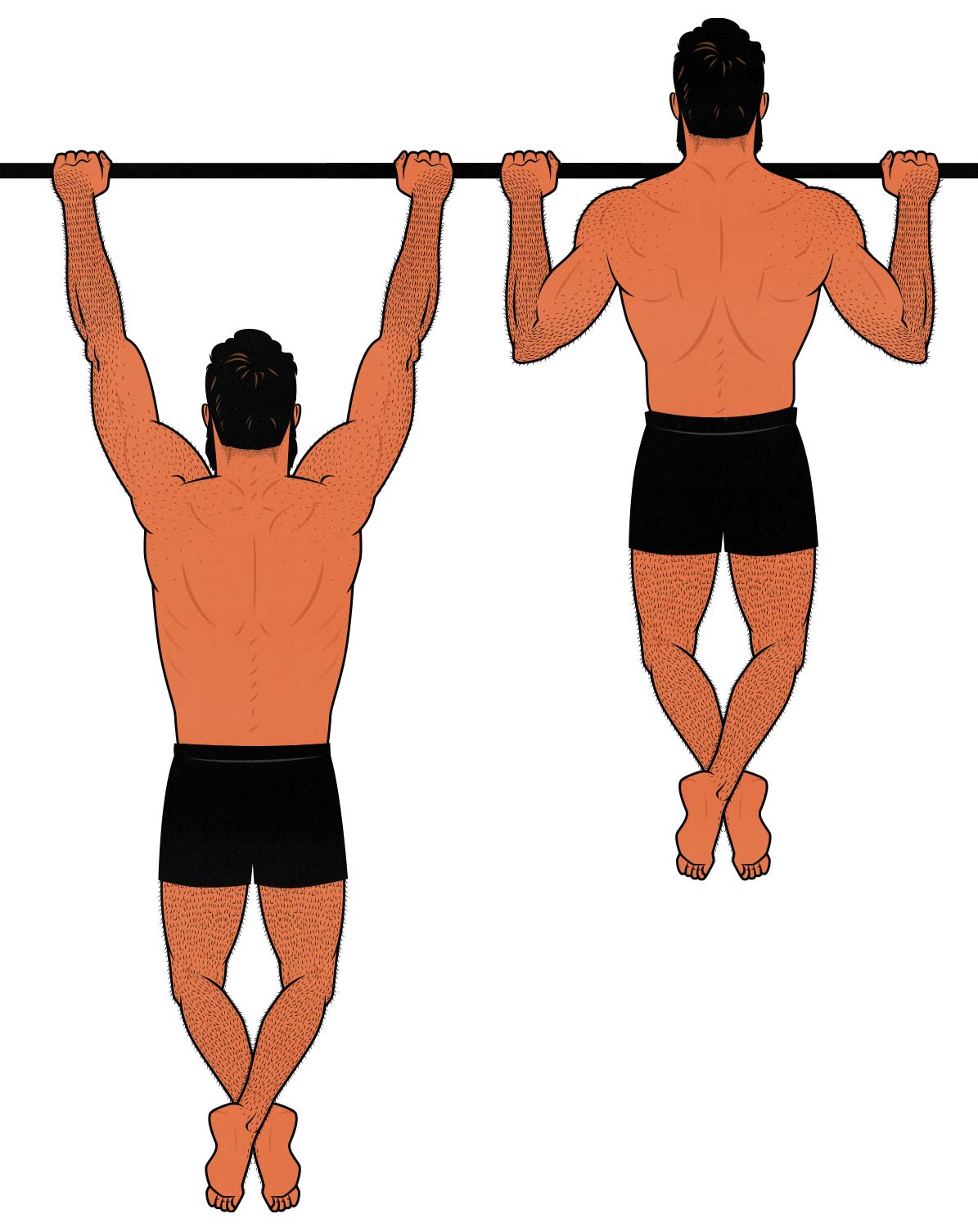
Shoulder Exercises
Your shoulders are your biggest upper-body muscle, but sometimes it’s better to think of them as three different muscles. Your front delts work with your chest, your rear delts work with your back, and your side delts work with your upper traps when you raise your arms out to the side.
I’m not including push-ups, bench presses, and dips here because they’re in the chest section. I’m not including chin-ups, pull-ups, and rows because they’re in the back section. These are the shoulder exercises you’d add to those.
- The overhead press is the best overall shoulder exercise. It’s difficult to master, but it’s heavy, stable, and engages most of the muscles in your body. It’s great for your front delts and good for your side delts. You can do it with barbells, dumbbells, or exercise machines.
- Face pulls are good for your rear delts. Most pulling exercises are. Your rear delts don’t always need extra attention. What makes face pulls nice is that they work your entire rotator cuff through external rotation, which isn’t trained by many compound exercises.
- Lateral raises are the best exercise for your side delts, and they also do a good job of working your upper traps and the wrist extensors that run along the backs of your forearms. You can do them with dumbbells, weight plates, or cables, either standing or lying down.
- Upright rows are controversial because they grate on some people’s shoulder joints. If they feel comfortable, though, they can be great for your side and rear delts.
Arm Exercises
Some of the muscles in your arms can be trained with pressing and pulling movements. Others cross more than one joint, making it difficult for them to engage while you’re moving at more than one joint (study). In particular, the long heads of your biceps and triceps tend to benefit from isolation exercises.
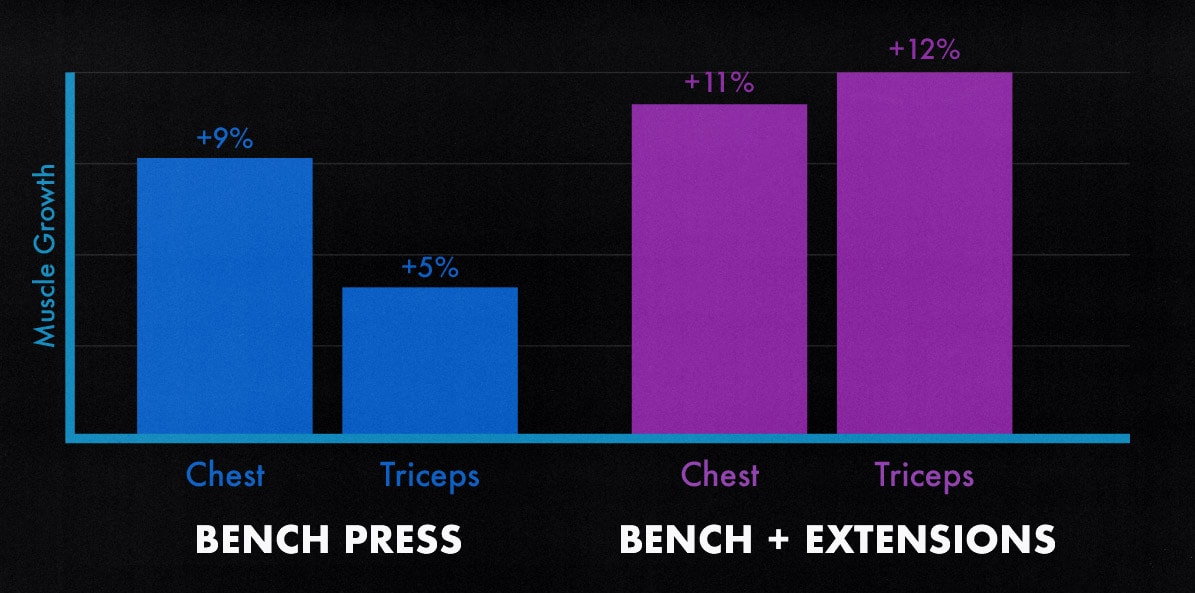
Here are a few of my favourite biceps exercises:
- Barbell curls are simple, stable, and easy to progressively overload. You can do them with a straight barbell or an angled curl-bar (aka EZ-Bar).
- Dumbbell Curls train your biceps in the same way as barbell curls. They aren’t quite as stable, but they tend to be easier on your elbow joints.
- Lying Dumbbell Curls challenge your biceps through a deep range of motion, stimulating a tremendous amount of muscle growth, especially in the long head. This is my favourite biceps exercise.
Here are a few of the best triceps exercises:
- Triceps pushdowns are easy to learn, easy on the elbows, and don’t require much shoulder mobility. They’re great for people with cranky shoulders and elbows.
- Skull crushers are famous as an assistance exercise for the bench press. They’re great for building bigger triceps, too. They work your triceps through a deeper range of motion, making them great for stimulating muscle growth.
- Overhead extensions maximally stretch the long head of your triceps at the shoulder joint, stimulating the most muscle growth (study).
You may also want to include some forearm curls. You work your forearm flexors during biceps curls. They keep your wrists from bending back. But they’ll grow a bit faster if you isolate them.
Neck Exercises
I haven’t been able to convince my wife to build a powerful neck, so I doubt I can convince you. But if you want, you can include some neck exercises. More on that here.
The Workouts
There are a few different ways you can program Upper/Lower Workout Splits. One option is to use undulating periodization, where the first upper-body workout is heavier and the second is lighter.
Another popular approach is to have one upper-body workout that supersets horizontal pulling with pressing (bench presses and rows) and a second that supersets vertical pushing with pulling (chin-ups and overhead presses).
Or you could have 3 upper-body workouts, each built around one of the 3 main upper-body exercises: bench presses, chin-ups, and overhead presses.
Heavy & Light Workouts
These workouts are part of a 4-day split. They use undulating periodization, which is great for gaining size, maximal strength, and explosive power. It’s popular among athletes. This is the approach Marco used when training professional football players and Olympic rugby players.
| EXERCISE | SETS | REPS |
|---|---|---|
| Bench Press | 4 sets | 6–8 reps |
| Weighted Chin-Ups | 4 sets | 6–8 reps |
| Overhead Press | 3 sets | 6–8 reps |
| T-Bar Rows | 3 sets | 6–8 reps |
| Curl-Bar Curls (Optional) | 3 sets | 8–12 reps |
| Skull Crushers (Optional) | 3 sets | 8–12 reps |
This is the heavier upper-body day, with the emphasis on getting stronger at the bench press, chin-up, and overhead press. If you want bigger arms, best to include some arm exercises. I recommend resting for around 3 minutes between sets on the first 4 exercises.
| EXERCISE | SETS | REPS |
|---|---|---|
| Pull-Ups | 3 sets | AMRAP* |
| Push-Ups (or Dips) | 3 sets | AMRAP |
| Dumbbell Press | 3 sets | 12 reps |
| Dumbbell Row | 3 sets | 12 reps |
| Lying Dumbbell Curl | 3 sets | 15 reps |
| Dumbbell Overhead Extension | 3 sets | 15 reps |
This is a lighter workout focused on muscle hypertrophy and work capacity. I recommend supersetting the exercises together, alternating between push-ups and pull-ups, presses and rows, and curls and extensions. If you superset the exercises, you can rest for a minute between each set of each exercise.
Vertical & Horizontal Workouts
These workouts are usually part of a 4-day split. They’re built around supersets, keeping the workouts shorter, denser, and more efficient—without sacrificing any muscle growth. Instead of resting 2–4 minutes between sets, you alternate between two different exercises, resting for just 1–2 minutes between each set.
| Exercise | Sets | Reps |
|---|---|---|
| Dumbbell Bench Press | 4–5 sets | 6-12 reps |
| Dumbbell Rows | 3–5 sets | AMRAP* |
| Lying Dumbbell Curls | 3 Sets | 10–15 reps |
| Skull Crushers | 3 sets | 10-15 reps |
| Pullovers | 3 sets | 12–15 reps |
The first workout focuses on horizontal pushing and pulling. I like supersetting the dumbbell bench press and row, using the same dumbbells for each. Choose a weight that lets you do 6–12 reps of the bench press, then row that weight for as many reps as you can muster.
| Exercise | Sets | Reps |
|---|---|---|
| Overhead Press | 4–5 sets | 6–10 reps |
| Chin-Ups | 4–5 sets | AMRAP |
| Lat pulldowns | 3 sets | 8–12 reps |
| Barbell Curls | 3 sets | 10-15 reps |
| Overhead Extensions | 3 sets | 10-15 reps |
| Lateral Raises | 3 sets | 12–15 reps |
The second workout focuses on vertical pushing and pulling. I like supersetting overhead presses with chin-ups because you can often do them in the same squat rack. Do your lat pulldowns with a different grip. If you’re doing chin-ups with a narrower neutral grip, do your pulldowns with a wider overhand grip.
The Big 5 Approach
This routine is part of a 5-day split, with each workout focused on a different compound lift: squat, bench, deadlift, chin-ups, and overhead press. This is somewhat akin to the training split we use in our Outlift Intermediate Hypertrophy Program. It’s incredibly good for gaining muscle size and strength.
| Exercise | Sets | Reps |
|---|---|---|
| Bench Press | 4–5 sets | 6-12 reps |
| Lat Pulldowns | 3–5 sets | 6-12 reps |
| Dumbbell Rows | 3 sets | 8–12 reps |
| Skull Crushers | 3 sets | 10-15 reps |
| Pullovers | 3 sets | 12–15 reps |
The first workout focuses on a variation of the bench press. You could do barbell bench presses, dumbbell bench presses, dips, or push-ups. The goal is to give the first lift your best effort. Try to get stronger at it. Try to add more weight or squeeze out more reps.
| Exercise | Sets | Reps |
|---|---|---|
| Weighted Chin-Ups | 4–5 sets | 5–8 reps |
| Push-Ups | 3–5 sets | AMRAP* |
| Barbell Curls | 3 sets | 10-15 reps |
| Overhead Extensions | 3 sets | 10-15 reps |
| Lateral Raises | 3 sets | 12–15 reps |
The second workout focuses on a variation of the chin-up. You could do chin-ups, pull-ups, pulldowns, or t-bar rows. Neutral-grip or angled-grip chin-ups make for a great default.
| Exercise | Sets | Reps |
|---|---|---|
| Overhead Press | 4–5 sets | 6-12 reps |
| Pull-Ups | 3–5 sets | AMRAP |
| Dips | 3 sets | AMRAP |
| Dumbbell Curls | 3 sets | 10-15 reps |
| Forearm Curls | 3 sets | 12–15 reps |
The third workout focuses on a variation of the overhead press. You could choose a barbell overhead press, push press, dumbbell overhead press, or incline bench press.
Workout Guidelines
An upper-body workout might sound like something a bodybuilder would do, but it’s usually part of the strength and performance tradition. That means focusing on progressive overload, ample rest times, and lifting with an explosive tempo.
- Volume: We have 4–6 exercises for 3–4 sets. That’s a great default, but feel free to add or remove sets and exercises.
- Progression: The goal is to gradually get stronger at the bigger, heavier exercises. In the 4-day routine, that means adding weight on the heavy day. In the 5-day routine, that means giving your best effort to the first exercise of every workout.
- Rest times: If you’re supersetting the exercises, rest for up to 2 minutes between sets. If you aren’t supersetting, rest for up to 4 minutes between sets. Use shorter rest times for smaller exercises.
- Reps in Reserve: Leave 2–3 reps in reserve on your heavier exercises. Leave 1–2 reps in reserve on your smaller exercises. You can take the final set of each exercise to the cusp of muscle failure.
- Tempo: Try to lift the weights explosively, accelerating them through the beginning of the range of motion. Lower the weights slowly and under control. Give each rep your full effort.
- Muscle-Building Diet: You need enough food to fuel muscle growth. If you’re skinny-fat or overweight, you can get extra energy from your body fat. If you’re thin or lean, you’ll need to get that energy from food—you’ll need to gain weight.
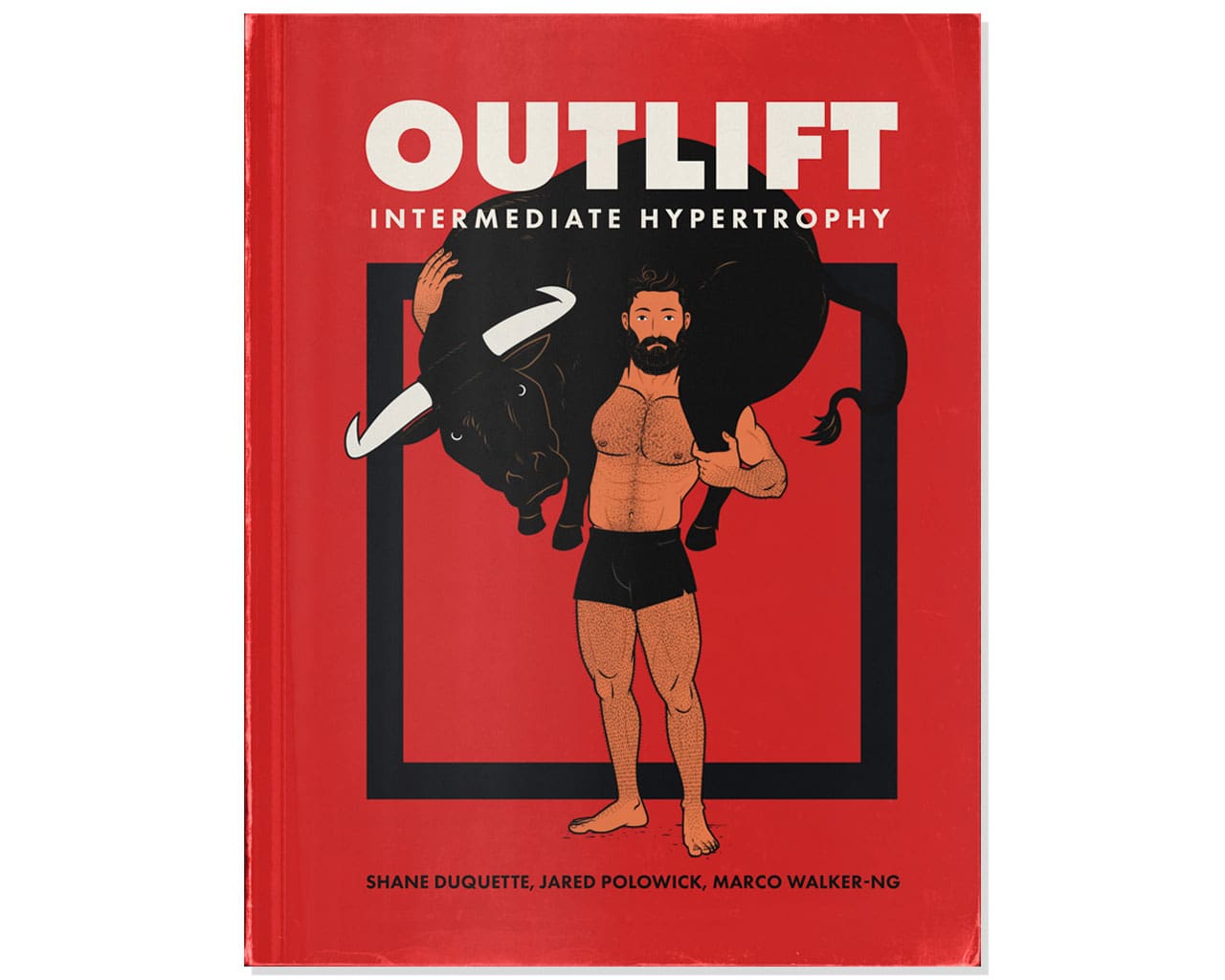
If you want a fully optimized 3-day, 4-day, and 5-day workout split, check out our Outlift Intermediate Hypertrophy Program. It’s a 15-week customizable workout routine with guided progressive overload. It also comes with a full hypertrophy training guide. I think you’d really like it.



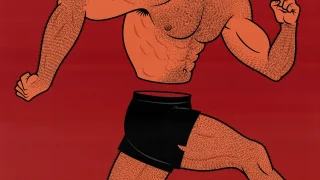
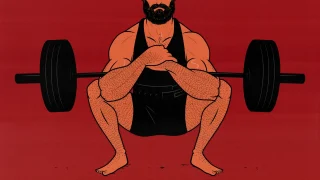
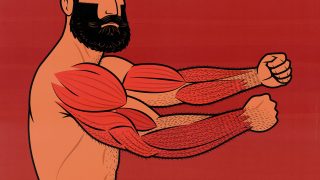

Thanks for another great article, Shane. In “The Best Exercises” section you don’t have a subsection on Shoulders, though you do have separate subsections for Chest, Back, Arms and even Neck (life your wife, I remain unconvinced of the necessity). In the following section called “The Workouts” you do of course mention shoulder exercises. I’m thinking maybe an oversight?
Thanks, Darren! Yeah, that’s a good point. I have an entire article about the Shoulder Days that slot into Bro Splits. I was trying to condense this one down. I was mentioning chest exercises that were good for the front delts and back exercises were good for the rear delts. I thought maybe a shoulder section wasn’t needed. You’re making a good point, though. I’ll add the shoulder exercises now 🙂
I have a genetically exceptionally skinny neck. It was a game-changer when I learned I could make it bigger. You can skip it, though. Training your neck isn’t necessary unless you wrestle, box, do mixed martial arts, play combat sports, or want to headbang like Corey Taylor.
To your point, I have noticed in the pictures of guys who complete b2B, in some their necks look relatively skinny once they’re jacked. When they were skinny everywhere you don’t notice it but the difference shows up later. If I get jacked like that then perhaps I’ll feel the need. May I ask: what was your neck measurement before you started training it and what is it now?
Yeah, totally. No need to train it right away. It has nowhere to go. It will wait for you.
My neck started at around 13.5 inches. It grew to a little over 14 inches after I gained my first 20 pounds. I gained another half inch as I gained another 40 pounds, getting up to 14.5. That’s when I realized things had gotten out of proportion.
After directly training my neck for a few months, I brought my neck up to my goal size of 16 inches, the same size as my arms. I think my neck (and arms) are closer to 15.5 now that I’m not training them as intently, but that’s fine by me.
Very good.